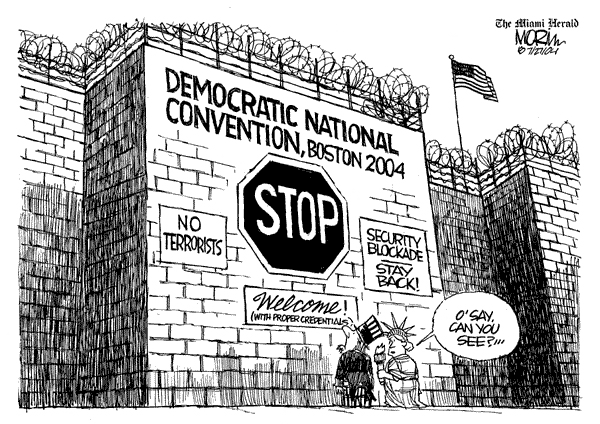Today we are lucky to have a guest contribution to WorkingDefinition. In the following essay, Nate describes what makes Neocons tick and what we, as responsible and progressive Democrats, can do to counter their disproportionate influence. Enjoy!
On the Highroad to Irrelevance: Rebuilding the Democratic Party
Introduction
The term neoconservative is often used to describe the Bush administration. To many Democrats the term neoconservative is an insult, and rightfully so, an epithet, thrown as Bush himself throws the term “Massachusetts politician,†meaning a weird mixture of born-again Christianity, a smug self-satisfaction and an almost dangerous confidence that anything America touches will doubtlessly turn to gold. This is not too far off the mark but it fails in the major point that it is unable to uncover or unlock the secret of what makes neoconservatism so attractive to so many Americans.
We would best begin by defining our terms. While neoconservatism is the guiding philosophy of the Republican party, neoconservatism is not Republicanism; in fact I do not believe that it would be stretching the truth to say that neoconservatism is now operating in the burned-out shell of the Republican party the way certain parasites burrow into the brains of caterpillars and then take over their bodies – the caterpillar is no longer in control, but it still looks like a caterpillar. Therefore, as we read research and write, we would do well to understand that while they are currently synonymous, Republican and neoconservative do not mean the same thing.
One of the apostles of the neoconservative doctrine is commentator Irving Kristol. Kristol’s collection of essays: Neoconservatism: an Autobiography of an Idea provides an excellent explanation of this dichotomy. Kristol, whose two primary fears in life seem to be lesbians and African-Americans in that order, suggests that from the administration of Franklin Roosevelt until the early 1990’s, the Republican Party in the United States was largely dead. Dependent on raising the banner of anti-communism and fiscal responsibility Kristol states that the Republicans merely looked like miserly fear-mongers in the face of the high ideals of Democrats and as such made no progress, representing a minority in the House and Senate.
For Kristol, neoconservatism was the parasite that burrowed into the nearly defunct Republican party and gave it new life, the life that has given the party the wherewithal to capture all three branches of the United States government in a mere twenty years. At some level this understanding of neoconservatism existing inside the shell of the Republican Party can be comforting to Democrats. People who vote Republican believing they are voting for fiscal responsibility and small government may eventually realize that they are actually voting neoconservative thus causing a major rupture in the Republican ranks, but this supposed rupture might easily come too late to prevent an irreversible sea-change in American life and government.
The foregoing being said, it begs the question: if Republican doesn’t mean Republican anymore, and instead means neoconservative, why do people still vote for Republican candidates? Shallow pundits such as Anne Coulter would suggest glibly that anyone who doesn’t vote Republican (meaning neocon in this case) is a) unpatriotic, b) brain-dead, c) gay, d) an environmental nut, or e) all of the above. Alas for Coulter and her ilk their simplification of neoconservatism for a radio audience merely serves to highlight their own stupidity. The fact is that neoconservatism is a highly complex doctrinal system based on intense and perhaps fevered readings of history and classical philosophy with an emphasis on Socrates and Aristotle.
In my own work as a consultant for the non-profit sector I am often asked by struggling organizations “we do such good work, why don’t people want to fund us?†Often times we return to them with the same solution: “do only those things which directly advance your mission; package and clarify your work for funders.†If we can for a moment imagine neoconservatism as an automobile, the success of the doctrine becomes clear in short order; yes it has a complex supply line, yes building it is a lengthy and involved process, but with a coat of well-lacquered paint anyone can tell you it’s a car. Taking the automotive analogy one step further, the hiding of neoconservatism within the Republican Party also helps to explain the doctrine’s success. Neoconservatism has enough parts drawn from classical Republicanism to appear very similar, almost indistinguishable to last year’s model such that a casual observer won’t be able to tell the two apart until he’s been driving long enough to read the fine print under the clock on the dashboard.

